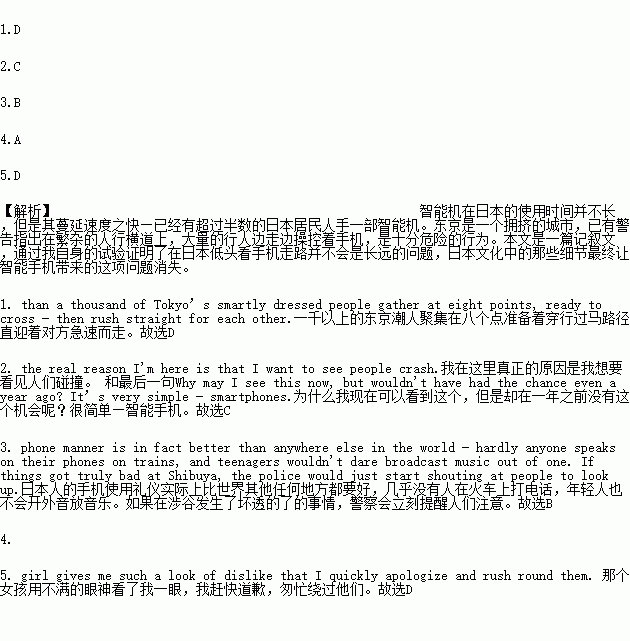题目内容
It’s 5pm on a Friday and I'm standing in a coffee shop above Shibuya crossing - one of the most busiest place in Japan where more than a thousand of Tokyo’s smartly dressed people gather at eight points, ready to cross - then rush straight for each other. It looks like they must bump into each other, but It’s amazing that they all manage to reach the other side safely.
But the real reason I'm here is that I want to see people crash. I want businessmen to knock into each other, their umbrellas flying off their arms, and uniformed schoolchildren hitting grannies. Why may I see this now, but wouldn't have had the chance even a year ago? It’s very simple - smartphones.
Smartphone use is booming in Japan. In 2012, only about a quarter of Japanese used them, most being perfectly happy with their everyday mobiles. But now more than half of all Japanese now own a smartphone and the number is rising fast. But with that rise has grown another phenomenon - the smartphone walk. Those people who're staring at a phone screen adopt this kind of pace- their head down, arms outreached, looking like zombies(僵尸)trying to find human prey(猎食).
Surprisingly, an American named Michael Cucek who has lived here for more than 20 years told me smartphone walk probably wouldn’t be a long-term problem. Japanese phone manner is in fact better than anywhere else in the world - hardly anyone speaks on their phones on trains, and teenagers wouldn't dare broadcast music out of one. If things got truly bad at Shibuya, the police would just start shouting at people to look up.
But really, is the smartphone walk such an annoying problem? There's only one way to find out. So I leave the coffee shop, head down to the crossing and start typing an email, promising myself I won't look up until I get to the other side. When they start walking past me, it's my time to cross. As I step forward, the experience quickly becomes nervous - legs jump in and out of my vision without warning, while shopping bags fly towards my face before being pulled away at the last moment. I'm sure I'm going to get hit, but after a few seconds I relax. It’s OK. Everyone's reacting for me.
I expect to see two smartphone walkers just like me. But instead I find a young couple, very much in love and very much refusing to let each other’s hands go just to give way to a fool on his smartphone. The girl gives me such a look of dislike that I quickly apologize and rush round them. That look was enough to ensure I'll never be smartphone walking again.
1. From paragraph 1, we can know _____________.
A. people at Shibuya crossing always bump into each other.
B. more than a thousand of people gather at Shibuya crossing every day.
C. more than a thousand of people are ready to rush in a competition every day.
D. more than a thousand of people at Shibuya crossing make it a busy one in Japan.
2.Why does the author stand in a coffee shop above Shibuya crossing?
A. Because he is waiting for somebody.
B. Because he can have a good view from there.
C. Because he wants to see what would happen because of smartphones.
D. Because it’s interesting to see businessmen’s umbrellas flying off their arms
3. How does Michael Cucek find smartphone walk in Japan?
A. He found it by accident when he lives here.
B. Japanese pay much attention to their phone manner in public.
C. The police in Shibuya are too strict with people’s phone manner.
D. Smartphone walk in Japan has a deep root.
4. How does the author confirm whether smartphone walk is annoying or not?
A. By personal experimenting
B. By comparing with other way of walk
C. By giving example.
D. By explaining the traffic rules patiently
5.After smartphone walking himself, the author thinks___________.
A. it’s exciting to walk while sending emails
B. it’s really dangerous to walk while sending emails
C. there are some others smartphone walking like him
D. other passers-by give way to him although they dislike.
 名校课堂系列答案
名校课堂系列答案
